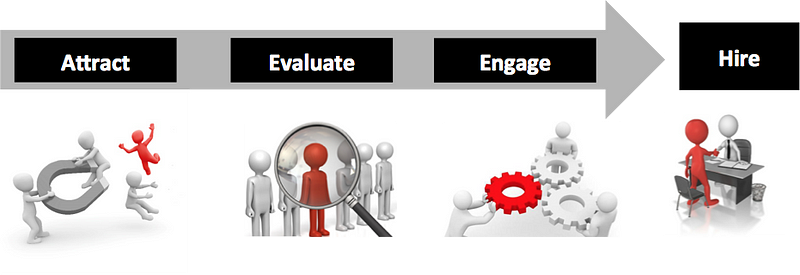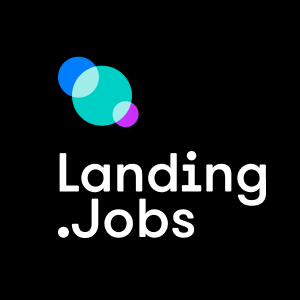This is part one of “How to compete in a Candidate-driven Market”. Click to read part one, three and four.
On our first post, we covered what’s going on in this present Candidate-driven Market. Now, let’s talk about new and better recruitment processes and approaches. Broadly speaking, this is what your process should look like:

Let’s break it all down. This post is all about the different ways of attracting new candidates for your business. This may be surprising, but no one looks for jobs in newspapers anymore. Shocker, right?
Attract — How to make candidates drool over you
First of all, you have to make yourself visible and alluring as a brand and as an employer. If you’re approaching a candidate with a hot shot attitude and are under the impression you offer the best employee experience but somehow can’t seem to get anyone to apply to your job offers, that must mean something, right?
Right.
That’s because it takes effort. And if you happen to be hiring in, say, the accounting business, I’m afraid it takes even more effort (no one likes accountants, I’m sorry).
Whether you have a line at the door or the only email that visits your inbox is the occasional you-just-won-a-million-dollars spam, make sure you know which of the following approaches and tools are essential, and which ones are downright from the stone age:
Employer Branding
Ah, branding. The last thing you need is a couple of design nutters telling you what to do with your brand. Guess what: it works.
Employer branding is, perhaps, the most important element of your company. A strong and authentic brand image is paramount in a Candidate-driven Market, and it affects e-ver-y-thing. Most of the candidates you’re targeting will rely on what they find on your company and look for others to create an unbiased picture in their heads.
With a weak and doubtful employer brand image, you may very well stand no chance in landing a top talent.
Social Media
It won’t stop growing, and almost every brand tries to find its place in it. Social media can be a fickle friend if badly managed, but it can be your bestie when it comes to recruitment. Most of the candidates will rely on it and on your corporate website to get to know your company, thus they both need to be compelling and superior to your competitors.
Also, being able to use LinkedIn to upload profiles instead of obliging candidates to fill in CVs will give you an advantage, plainly because it’s quick and painless and that’s what people want. The first and every approach should feel like a smooth landing, complete with an authentic employer brand image and a fast recruitment process in its cargo.
Job Boards
Candidates are sick of them. They represent the hellhole of dull, tiresome job ads that sum up 90% of the job offers out there, and may lead to a high volume of crappy CVs. If you do use them, candidates are going to need much more from you; that means position descriptions must be compelling.
And yes, that means showing salary ranges. As a hiring manager, you want candidates to be transparent in their background, so the least you should do is present them with a straightforward salary range. The more transparent you are in your job offers, the less CVs you have to sort through because candidates with a clear idea of current market salaries already know what to expect and if they’re suited or not for the position. It saves everyone’s time.
Placing ads on job boards shouldn’t be the only sea you’re fishing in, and if you’re spending your recruitment budget on job board listings alone, let me tell you, it’s not going to cut it.
Recruitment Agents VS Recruitment Marketplaces
Ah, the HR guys. Nothing painless about them. As opposed to a few different approaches we’ll be looking into, these agents are always seen as greedy middlemen who want to have the upper hand over everyone. Their figures and commissions are the only thing that matter, and the selection of talent leaves a lot to be desired, especially because of their lack of knowledge in the industry. Even with their fancy LinkedIn Premium and search perks, headhunters still can’t seem to live up to the task of finding good talent.
Up-and-coming marketplaces, however, ensure quality selection processes, unlike all the unsuitable and time wasting applications that come from job boards and recruitment agencies. Landing.jobs is the perfect example of a platform that dedicates itself to matchmaking top talent and quality job opportunities to companies who are desperate for them.
Referrals
They are your most powerful asset. Great when you’re trying to find a candidate, and even better when you’re trying to sell yourself as a brand. Who better to sell your company’s values than your current employees? Referrals have become crucial, and the numbers prove it. 40% of tech candidates come from referrals and they produce the highest quality hires.
Referrals can be used very early on in the recruitment process, and it’s a great way to evaluate candidates. Maximising the use of referrals using crowdsource models where everyone can be a referrer is a great thing for your team, and the best way to convince skeptical talents to take a job in your company.
Above all, candidates should ideally be contacted with direct approaches. Make it personal. A more proactive style of recruiting builds a stronger relationship when it comes to sourcing high demand talent who already have a job. Building trust and nurturing relationships one by one will give recruiters a more likely opportunity for these professionals to apply for another job.
Why not organise an event? Introducing yourself and making the time to get to know potential candidates takes your employer brand to the next level, like we did at the Landing.jobs Festival. Don’t make it a “job fair”, turn it into an experience. Something unusual and attractive. We rented a boat and launched a sardine into space. Creativity knows no limits. Make them remember you!
Click here to read Part Three of “How to compete in a Candidate-driven Market”, where we cover the next step of the ideal recruitment process: knowing the right moment to contact candidates, and evaluating who is the best one for the job.






0 Comments